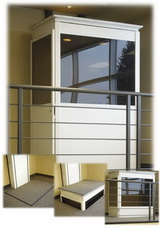Cable Elevators
Of all the types of elevators on the market, by far the most popular are cable elevators. They are the most conventional in design and have been among the very first elevators in use. Most often they are driven by an electric motor, but unlike hydraulic elevators, cable elevators have the mechanics above the elevator shaft rather than below it! They can be designed to have both front and rear access to the elevator car and can be manufactured to hold great amounts of weight.
Mechanics of Cable Elevators
The main difference between a hydraulic elevator and a cable elevator is that is raised and lowered from above by traction steel chains rather than being pushed from below. These changes are attached to the elevator car and then around sheave will which is actually a simply a pulley with grooves going around the circumference. These grooves are what grip the ropes (chains) to raise and lower the elevator. All of this is connected to a motor that rotates the sheaves. These changes also have a counterweight connected to them which hang on the other side of the sheave. It is interesting to note that these counterweights are designed to weigh approximately the same as in elevator car which is loaded to 40% capacity. So for example when the elevator car is at 40% capacity, the car in a counterweight will be perfectly well-balanced.
Built-In Safety Measures
One common question many people ask is what will happen if the ropes/chains should suddenly snap and break. There are a number of failsafes built in to cable elevators to prevent the elevator from plummeting many stories to the bottom level. The safeties are series of braking systems that can grab the rails which are located on the elevator shaft. Some types of braking systems clamp onto the rails while others push a wedge into a notch on the rail. Most often will this type of safety is activated by a device called in mechanical speed governor. Basically, the governor is simply a pulley which rotates with elevator movement and when it spins too fast the braking system is activated by centrifugal force. However, even if these sophisticated braking systems should fail there are also a couple of safety features which taken at the bottom. One is a system of shock absorbers in the other is simply the laws of physics. And the elevator falls there will compress and blunt the impact.
Cable elevators are the most conventional type of elevators on the market notwithstanding among the first ever designed. They have proven to be safe and although they may be a bit noisier and perhaps hydraulic elevators or pneumatic elevators they can carry a great deal of weight just as hydraulic elevators can. For this reason, cable elevators are often installed with greater amounts of weight will need to be lifted such as in large office buildings and public places. They are generally built into a structure during construction but are actually easier to add and hydraulic elevators to existing structures because the mechanics are above the elevator shaft rather than below it.

